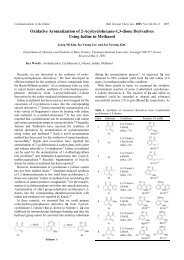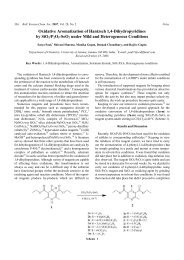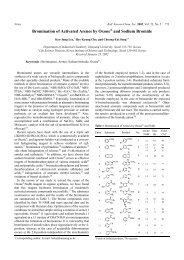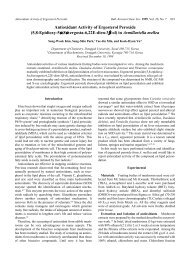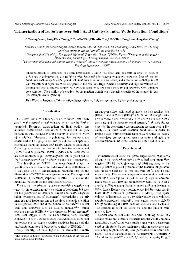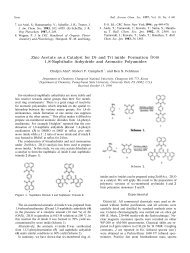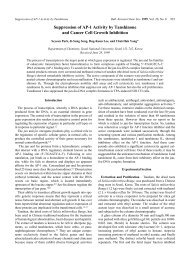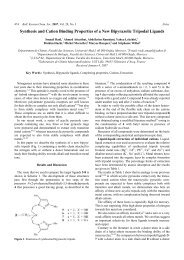New Mechanism for the Reaction of Thianthrene Cation Radical ...
New Mechanism for the Reaction of Thianthrene Cation Radical ...
New Mechanism for the Reaction of Thianthrene Cation Radical ...
Create successful ePaper yourself
Turn your PDF publications into a flip-book with our unique Google optimized e-Paper software.
<strong>Thianthrene</strong> <strong>Cation</strong> <strong>Radical</strong> <strong>Reaction</strong> with t-Butyl Peroxide Bull. Korean Chem. Soc. 2002, Vol. 23, No. 1 103<br />
<strong>New</strong> <strong>Mechanism</strong> <strong>for</strong> <strong>the</strong> <strong>Reaction</strong> <strong>of</strong> <strong>Thianthrene</strong> <strong>Cation</strong> <strong>Radical</strong><br />
Perchlorate with tert-Butyl Peroxide<br />
Bo Kyung Park, Chang Kook Sohn, and Wang Keun Lee *<br />
Department <strong>of</strong> Chemistry Education, Chonnam National University, Kwang-Ju 500-757, Korea<br />
Received October 24, 2001<br />
A new reaction mechanism is proposed <strong>for</strong> <strong>the</strong> reaction <strong>of</strong> thianthrene cation radical perchlorate (Th +· ClO4 − )<br />
and tert-butyl peroxide in acetonitrile at room temperature on <strong>the</strong> basis <strong>of</strong> experimental and <strong>the</strong>oretical results.<br />
Rapid C-O bond rupture instead <strong>of</strong> O-O bond cleavage was observed by a good peroxy radical trapping agent,<br />
thianthrene cation radical. Products were N-tert-butyl acetamide, thianthrene 5-oxide (ThO), thianthrene 5,5dioxide<br />
(SSO2), and thianthrene (Th). <strong>Thianthrene</strong> 5,10-dioxide (SOSO) was not obtained. A comparative<br />
computational study <strong>of</strong> <strong>the</strong> cation radical <strong>of</strong> tert-butyl peroxide is made by using B3LYP and CBS-4. The<br />
computational results are helpful to explain <strong>the</strong> reaction mechanism.<br />
Keywords : <strong>Thianthrene</strong> cation radical, t-Butyl peroxide, B3LYP and CBS-4 methods.<br />
In <strong>the</strong> course <strong>of</strong> studies in <strong>the</strong> C-O bond cleavages by oneelectron<br />
oxidant, thianthrene cation radical perchlorate<br />
(Th +· ClO4 − , 1), we have discovered that thianthrene cation<br />
radical is a good peroxy radical trapping agent. In this study,<br />
a new reaction mechanism is proposed on <strong>the</strong> basis <strong>of</strong> our<br />
experimental and <strong>the</strong>oretical results <strong>for</strong> <strong>the</strong> particular case <strong>of</strong><br />
1 and tert-butyl peroxide (2). Dialkyl peroxides usually give<br />
in <strong>the</strong> initial stage two alkoxy radicals via O-O homolysis on<br />
photochemical and <strong>the</strong>rmal decomposition, which are apt to<br />
react fur<strong>the</strong>r with o<strong>the</strong>r substrates or decompose to more<br />
stable compounds. 1 Likewise, 2 undergoes conventional<br />
<strong>the</strong>rmolysis into tert-butoxy radicals in solution at reasonable<br />
rates only if heated at above 100 o C. 2 In contrast,<br />
reaction <strong>of</strong> this very stable 2 with 1 at room temperature<br />
leads to rapid C-O bond rupture instead <strong>of</strong> O-O cleavage.<br />
The subjects <strong>of</strong> this report are <strong>the</strong> issue <strong>of</strong> electron transfer<br />
versus nucleophilic addition, and <strong>of</strong> C-O cleavage versus<br />
O-O cleavage.<br />
In <strong>the</strong> present study, we have carried out <strong>the</strong> reaction <strong>of</strong><br />
2:1 Th +· /2 stoichiometry in MeCN at room temperature and<br />
products were N-tert-butyl acetamide (3, 80%, 0.80 mmol),<br />
thianthrene 5-oxide (ThO, 96%, 0.48 mmol), thianthrene<br />
5,5-dioxide (SSO2, 52%, 0.13 mmol) and thianthrene (Th,<br />
104%, 0.26 mmol) as determined by quantitative GC and<br />
GC/MS analyses (Scheme 1). Work somewhat analogous to<br />
ours has been reported by Kim and Shin 9 , which describes<br />
<strong>the</strong> nucleophilic addition <strong>of</strong> 2 to 1 in a molar ratio <strong>of</strong><br />
1.23:1.00 and <strong>the</strong> characteristics <strong>of</strong> oxidation <strong>of</strong> thianthrene,<br />
reduced oxidant. Kim had shown that <strong>the</strong> major products<br />
were not characteristic <strong>of</strong> tert-butyl cations but acetone was<br />
obtained from tert-butyl peroxy radical. For example,<br />
products <strong>of</strong> <strong>the</strong> reaction in MeCN at room temperature were<br />
Th (66%), ThO (27%), thianthrene 5,10-dioxide (SOSO,<br />
7.7%), 5-acetonylthianthrenium perchlorate (1.1%), and 3<br />
(12%). Unusual is that, in <strong>the</strong> report <strong>of</strong> Kim nor SSO2 was<br />
* Corresponding Author. Tel: +82-62-530-2493; Fax: +82-62-<br />
530-2499; e-mail: wklee@chonnam.ac.kr<br />
Scheme 1<br />
<strong>for</strong>med at room temperature but more SOSO was obtained<br />
than SSO2 at reflux temperature.<br />
In our reaction, SOSO and 5-acetonylthianthrenium perchlorate<br />
were not observed but SSO2 10 was obtained as <strong>the</strong><br />
only product <strong>of</strong> a second oxidation <strong>of</strong> Th. The major<br />
products are characteristic <strong>of</strong> tert-butyl cations, which says<br />
predominantly carbocationic chemistry is observed from an<br />
alkyl peroxide, a traditional source <strong>of</strong> free radical. 1 While 1<br />
was reduced quantitatively to Th, <strong>the</strong> major product from 2<br />
was 3. Without doubt, this product arose from hydration,<br />
during work-up, <strong>of</strong> a Ritter-type intermediate (Me3CN= + CMe)<br />
from reaction <strong>of</strong> Me3C + with solvent MeCN. Carbocationic<br />
chemistry was observed predominantly in <strong>the</strong> reaction <strong>of</strong> azo<br />
compounds, 5-7 carbonates, 8,9 carbamates, 10 with 1 in <strong>the</strong>se<br />
laboratories recently. Accordingly, all reactions were carried<br />
out with 2 : 1 stoichiometry <strong>of</strong> 1 and oxidized compounds.<br />
Generally, in reactions <strong>of</strong> 1, ThO is obtained as a side<br />
product from hydrolysis <strong>of</strong> 1 by water ei<strong>the</strong>r adventitiously<br />
in <strong>the</strong> solvent or added during workup. 11 However, in <strong>the</strong>se
104 Bull. Korean Chem. Soc. 2002, Vol. 23, No. 1 Bo Kyung Park et al.<br />
reactions <strong>the</strong> ThO was a primary ra<strong>the</strong>r than a side product<br />
<strong>of</strong> all reactions. This result suggests that <strong>the</strong> oxygen atom in<br />
ThO comes entirely from 2. The <strong>for</strong>mation <strong>of</strong> ThO as a<br />
primary product has been previously reported from <strong>the</strong><br />
reactions <strong>of</strong> oximes, 12 cyclic alcohol, 13 and 2,3-dimethyl-<br />
2,3-butanediol 14 with 1.<br />
In order to exclude all doubts <strong>of</strong> autocatalytic effects by<br />
<strong>the</strong> trace acid generated from <strong>the</strong> electron transfer (ET)<br />
reaction, we have conducted a control reaction <strong>of</strong> perchloric<br />
acid and 2 in acetonitrile. Quantitative amounts <strong>of</strong> starting<br />
peroxide, 2 were recovered. These observations indicate that<br />
<strong>the</strong> oxidative C-O cleavage <strong>of</strong> 2 is not catalyzed by <strong>the</strong> acid<br />
but is proceeded by ET mechanism exclusively.<br />
A comparative computational study as well as experimental<br />
studies on <strong>the</strong> fate <strong>of</strong> newly-<strong>for</strong>med tert-butyl peroxide<br />
cation radical, 2 +· will give a clue to explain <strong>the</strong><br />
fragmentation patterns <strong>of</strong> <strong>the</strong> alkyl peroxide cation radical.<br />
In practice, cation radicals pose a challenge to computational<br />
chemistry. However, standard ab intio computational methods<br />
such as unrestricted Hartree-Fock (UHF), even with corrections,<br />
have been found to yield erroneous results in certain<br />
cases. This makes it necessary to go to much higher<br />
computational levels that are intrinsically more accurate to<br />
investigate <strong>the</strong> reaction pathways <strong>of</strong> cation radicals. The<br />
ano<strong>the</strong>r goal <strong>of</strong> this paper is benchmarking <strong>the</strong> newly<br />
developed high-level ab initio method CBS-4 using <strong>the</strong><br />
CBS-4//B3LYP/6-31G* basis level 15 <strong>for</strong> <strong>the</strong> calculation <strong>of</strong><br />
<strong>the</strong> peroxide cation radical. The CBS results are compared<br />
with <strong>the</strong> B3LYP density functional <strong>the</strong>ory (DFT) approach<br />
using <strong>the</strong> B3LYP/6-31G*//B3LYP/6-31G* basis level. 16 In<br />
comparision, B3LYP is more computationally efficient than<br />
CBS-4, 17 but both calculations make similar predictions<br />
regarding <strong>the</strong> experimental results. Inspection <strong>of</strong> Table 1<br />
shows that B3LYP and CBS-4 do not differ dramatically, but<br />
<strong>the</strong> ab initio method gives higher energy value except<br />
entropy in comparision with <strong>the</strong> B3LYP. However, it presents<br />
challenges to computational chemistry to assess which<br />
method is more reliable and available <strong>for</strong> cation radical<br />
model chemistry. All structures including <strong>the</strong> cation radical,<br />
radicals, and neutral species were fully optimized and all<br />
stationary structures were confirmed by vibrational frequency<br />
analyses. 18<br />
For <strong>the</strong> decomposition <strong>of</strong> 2 +· four possible fragmentation<br />
patterns can be considered: (a) concerted pathway, (b) tertbutylperoxy<br />
radical and tert-butyl cation, (c) tert-butylperoxy<br />
cation and tert-butyl radical, and (d) tert-butoxy cation<br />
and tert-butoxy radical. However, in <strong>the</strong> calculations at<br />
B3LYP/6-31G* level, <strong>the</strong> tert-butylperoxy cation and tertbutoxy<br />
cation, which will be produced by paths (c) and (d)<br />
respectively, were not existed as stable species on <strong>the</strong><br />
potential energy surface (PES). Thus, <strong>the</strong> pathways (c) and<br />
(d) can be excluded. This indicates that <strong>the</strong> fragmentation<br />
proceeds via <strong>the</strong> concerted pathway (a) or stepwise pathway<br />
(b), which <strong>the</strong> tert-butyl cation, tert-butyl radical and oxygen<br />
molecules would be <strong>for</strong>med in <strong>the</strong> absence <strong>of</strong> second<br />
molecule <strong>of</strong> Th +· and solvent. This results is well agreed with<br />
<strong>the</strong> experimental findings. However, un<strong>for</strong>tunately, we can<br />
Figure 1. Optimized structures at UB3LYP/6-31G* level. Bond<br />
lengths are in A and values in paren<strong>the</strong>ses are spin densities in au.<br />
not determine which pathway, (a) or (b), is more favorable,<br />
since <strong>the</strong> transition state (TS) structures on <strong>the</strong> PES <strong>of</strong> paths<br />
(a) and (b) are not able to locate in <strong>the</strong> <strong>the</strong>oretical<br />
calculations. We can not acquire any in<strong>for</strong>mation <strong>for</strong> <strong>the</strong><br />
multiplicities in <strong>the</strong> expecting TS structures because <strong>the</strong><br />
complicate multiplicity changes are accompanied in <strong>the</strong> both<br />
decomposition processes through reaction paths (a) and (b).<br />
Never<strong>the</strong>less, it can be predicted that <strong>the</strong> stepwise path (b) is<br />
more plausible, since <strong>the</strong> t-butylperoxy radical (4) is existed,<br />
and relatively stable that it could not decompose or oxidize,<br />
although <strong>the</strong> TS structure are not located in this path. The<br />
2 +·
<strong>Thianthrene</strong> <strong>Cation</strong> <strong>Radical</strong> <strong>Reaction</strong> with t-Butyl Peroxide Bull. Korean Chem. Soc. 2002, Vol. 23, No. 1 105<br />
Table 1. Comparative Computational Energies between Reactant<br />
(2 +· ) and Products (4 and tert-Butyl <strong>Cation</strong>)<br />
Energy (unit) DFT (B3LYP) CBS (CBS-4)<br />
E (hartree) 33.72 43.05<br />
EZPE (hartree) 29.83 39.17<br />
H (hartree) 30.42 39.76<br />
S (e.u) 45.50 45.50<br />
G (hartree) 16.84 26.17<br />
fully optimized structures <strong>for</strong> <strong>the</strong> 2, cation radical 2 +· and 4<br />
with bond distances (Å) and bond angles (deg) along with<br />
spin density are depicted in Figure 1. The C-O-O valence<br />
angle <strong>of</strong> <strong>the</strong> cation radical is 100.1 o and <strong>the</strong> two-dimensional<br />
angle <strong>of</strong> <strong>the</strong> peroxides is 112.3 o . The cation radical 2 +· is not<br />
linear or positioned in same plane as expected. Thus it<br />
appears that <strong>the</strong> t-butyl carbon-oxygen bond breakage is<br />
occurred by shortening <strong>of</strong> C-O bond from 1.571 to 1.498.<br />
The spin density <strong>of</strong> oxygen atoms has changed from 0.481 in<br />
<strong>the</strong> cation radical to 0.691 and 0.305 in peroxy radical<br />
respectively. The result reveals that <strong>the</strong> majority <strong>of</strong> <strong>the</strong><br />
unpaired spins in <strong>the</strong> radical 4 has been shifted to <strong>the</strong><br />
terminal oxygen like in <strong>the</strong> case <strong>of</strong> <strong>the</strong> terminal oxygen <strong>of</strong><br />
tert-butoxycarboxyl radical <strong>of</strong> di-tert-butyl dicarbonate. 6<br />
The properties investigated include <strong>the</strong> structures and energetics<br />
<strong>of</strong> <strong>the</strong> cation radical as a reactant, tert-butyl cation and<br />
4 as intermediates (Table 1). Consequently, <strong>the</strong> cation radical<br />
2 +· , which was not in <strong>the</strong> stationary point, facile C-O breaking<br />
occurred at some stage under <strong>the</strong> oxidative conditions to<br />
give tert-butyl cation and 4 as drawn schematically in<br />
Scheme 2.<br />
Scheme 2<br />
The intermediate 4 is trapped by a second molecule <strong>of</strong><br />
Th +· , giving intermediate 5 (ROOTh + ). The amide 3, was<br />
<strong>for</strong>med by SN1 loss <strong>of</strong> 6 from <strong>the</strong> 5. In o<strong>the</strong>r words, peroxide<br />
transfer occurs with <strong>the</strong> <strong>for</strong>mation <strong>of</strong> <strong>the</strong> intermediate 6 and<br />
amide 3 <strong>of</strong> concordantly <strong>for</strong>med tert-butyl cations. Here, <strong>the</strong><br />
supposition is that 4 can not be oxidized by 1 and instead,<br />
attacks as a nucleophile to <strong>the</strong> cation radical. If tertbutylperoxy<br />
cations are <strong>for</strong>med by <strong>the</strong> oxidation <strong>of</strong> 4 <strong>the</strong><br />
perchloric acid salt, Me3COO + ClO4 − should be obtained.<br />
However, we could not find <strong>the</strong> salt from <strong>the</strong> product<br />
mixtures.<br />
It is necessary to account <strong>for</strong> <strong>the</strong> <strong>for</strong>mation <strong>of</strong> SSO2 and<br />
ThO from <strong>the</strong> intermediate 6. The sulfur containing dioxirane<br />
intermediate 6 exhibited two subsequent trans<strong>for</strong>mations:<br />
homolysis <strong>of</strong> <strong>the</strong> O-O bond which leads to SSO2 via <strong>the</strong> O=S<br />
bond <strong>for</strong>mation by radical coupling respectively. Oxidation<br />
<strong>of</strong> thianthrene by oxygen transfer from 6 with concomitant<br />
reduction <strong>of</strong> 6 to ThO as rationalized in Scheme 2. The<br />
stoichiometry <strong>for</strong> <strong>the</strong> <strong>for</strong>mation <strong>of</strong> ThO we have described<br />
calls <strong>for</strong> one half unit <strong>of</strong> 6 <strong>for</strong> a half unit <strong>of</strong> Th. Our balance<br />
<strong>of</strong> products, Th and ThO is in accord with this requirement.<br />
The oxidation mechanism <strong>of</strong> ThO by dimethyldioxirane 19 or<br />
peracid 20 is analogous to <strong>the</strong> present results. They have<br />
shown that <strong>the</strong> nucleophilic oxidant such as peracid and<br />
dimethyldioxirane led exclusively to oxidation <strong>of</strong> <strong>the</strong> sulfoxide<br />
site than nucleophilic sulfide site to <strong>the</strong> SSO2. In <strong>the</strong><br />
present reactions, since <strong>the</strong> sulfur, postulated intermediary 5<br />
is inherently electrophilic, only <strong>the</strong> sulfur containing dioxirane<br />
6 should be obtained from sulfoxide oxidation <strong>of</strong> 5.<br />
This observation strongly supports <strong>the</strong> possibility <strong>of</strong> Scheme<br />
2. In principle, <strong>the</strong> sum <strong>of</strong> <strong>the</strong> yields <strong>of</strong> Th and SSO2 should<br />
equal those <strong>of</strong> ThO. There are discrepancies in this run, <strong>for</strong><br />
example, <strong>the</strong> yield <strong>of</strong> SSO2 (52%) is less than expected, but<br />
<strong>the</strong> reason <strong>for</strong> which is not known. Un<strong>for</strong>tunately, we could<br />
not per<strong>for</strong>m an 18 O labeling experiment as a diagnostic aid in<br />
tracing <strong>the</strong> source <strong>of</strong> <strong>the</strong> ThO and SSO2 at this stage. In<br />
repeating our work with <strong>the</strong> electron transfer <strong>of</strong> peroxide to<br />
cation radical, we have found that both <strong>for</strong>mation <strong>of</strong> SSO2<br />
and SOSO in this ET reaction is by no means <strong>the</strong> rule. The<br />
possibility <strong>of</strong> SOSO <strong>for</strong>mation from 5 should be excluded<br />
because <strong>of</strong> electronic effects <strong>of</strong> <strong>the</strong> sulfur cation.<br />
In summary, application <strong>of</strong> B3LYP and high-level ab intio<br />
methods to investigate reliable structure <strong>of</strong> cation radical, its<br />
nature, and its energies reveals advantages to explain <strong>the</strong><br />
fragmentation mechanism <strong>of</strong> 2 with <strong>the</strong> reaction <strong>of</strong> sulfur<br />
cation radical, 1. In contrast with O-O homolysis <strong>of</strong> alkyl<br />
peroxide on photochemical and <strong>the</strong>rmal decomposition, a<br />
stable 2 has been shown to undergo C-O bond cleavage by<br />
sulfur cation radical 1 under mild conditions.<br />
Experimental Section<br />
<strong>Reaction</strong> <strong>of</strong> tert-butyl peroxide (2) with Th +· ClO4 − (1).<br />
A general procedure was adopted. tert-Butyl peroxide (73.12<br />
mg, 0.5 mmol) and Th +· ClO4 − (315.6 mg, 1.0 mmol) were<br />
placed in a 50 mL rounded-bottomed flask, containing a<br />
stirring magnet bar, and <strong>the</strong> flask was purged with dry argon
106 Bull. Korean Chem. Soc. 2002, Vol. 23, No. 1 Bo Kyung Park et al.<br />
after capping with a septum. Dry acetonitrile was introduced<br />
into <strong>the</strong> flask by syringe, and <strong>the</strong> dark purple color <strong>of</strong> 1 has<br />
disappeared, but <strong>the</strong> mixture was stirred overnight. Thereafter,<br />
10 mL <strong>of</strong> water was added followed by aqueous<br />
NaHCO3 to neutralize HClO4 that had been <strong>for</strong>med in<br />
reaction. The solution was extracted with 3 × 30 mL portions<br />
<strong>of</strong> methylene chloride. The methylene chloride solution was<br />
dried over MgSO4, and evaporated. The residue was<br />
dissolved in 10 mL <strong>of</strong> methylene chloride. Portions <strong>of</strong> this<br />
solution were used <strong>for</strong> identification <strong>of</strong> products by GC/MS<br />
and <strong>for</strong> quantitaitve analysis by GC. The column used was a<br />
2 × 1/8 in. stainless steel column packed with 10% OV-101<br />
on Chrom W, with naphthalene as an internal standard.<br />
Concentration factors <strong>for</strong> all products were determined with<br />
au<strong>the</strong>ntic materials.<br />
<strong>Thianthrene</strong>-5,10-dioxide (SOSO), 20 and thianthrene<br />
5,5-dioxide (SSO2), 20 were prepared as described in <strong>the</strong><br />
literature. The samples were submitted to GC and GC/MS<br />
analyses.<br />
t-Butylacetamide (3) 21 were prepared as described in <strong>the</strong><br />
literature.<br />
References and Notes<br />
1. Matsugo, S.; Saito, I. In Organic peroxides; Ando, W., Ed.; Wiley:<br />
<strong>New</strong> York, 1992; pp 157-194.<br />
2. Huyser, E. S. In Free-<strong>Radical</strong> Chain <strong>Reaction</strong>s; Wileyinterscience:<br />
<strong>New</strong> York, 1970; p 287.<br />
3. Shin, J.; Kim, K. Bull. Korean Chem. Soc. 1984, 5, 211.<br />
4. The retention time <strong>of</strong> thianthrene-5,10-dioxide (SOSO) and<br />
thianthrene 5,5-dioxide (SSO2) were <strong>the</strong> same as 26.10 min. in<br />
10% OV-101 on Chrom W packed column but mp and MS data<br />
were different <strong>for</strong>m each o<strong>the</strong>r. mp: SOSO; 249 o C, SSO2; 168-<br />
169 o C. MS data: m/e (relative intensity, %): SOSO; 248 (100),<br />
232 (30), 216 (30), 200 (73), 184 (89), 171 (60), 139 (22), 108<br />
(30), 96 (15), 74 (14). SSO2; 248 (100), 216 (12), 200 (38), 184<br />
(20), 171 (18), 139 (13), 108 (11), 100 (10).<br />
5. Bae, D. H.; Engel, P. S.; Hoque, A. K. M. M.; Keys, D. E.; Lee, W.<br />
K.; Shaw, R. W.; Shine, H. J. J. Am. Chem. Soc. 1985. 107, 2561.<br />
6. Lee, W. K.; Chung, C. T. Bull. Korean Chem. Soc. 1992, 13, 694.<br />
7. Chung, J. H.; Lim, S.-H.; Sohn, C. K.; Lee, W. K. Bull. Korean<br />
Chem. Soc. 1998, 19, 792.<br />
8. Park, Y. S.; Lee, W. K. Bull. Korean Chem. Soc. 1997, 18, 360.<br />
9. Choi, J. M.; Ma, E.-K.; Sohn, C. K.; Lee, W. K. Bull. Korean<br />
Chem. Soc. 2000, 21, 1254.<br />
10. Park, Y. S.; Han, D. S.; Lee, W. K. Bull. Korean Chem. Soc. 1998,<br />
19, 615.<br />
11. Shine, H. J.; Murata, Y. J. Org. Chem. 1969, 34, 3368.<br />
12. Chiou, S.; Hoque, A. K. M. M.; Shine, H. J. J. Org. Chem. 1990,<br />
55, 327.<br />
13. Shine, H. J.; Yueh, W. J. Org. Chem. 1994, 59, 3553.<br />
14. Han, D. S.; Shine, H. J. J. Org. Chem. 1996, 61, 3997.<br />
15. (a) Montgomery, J. A., Jr.; Ochterski, J. W.; Petersson, G. A. J.<br />
Chem. Phys. 1994, 101, 5900. (b) Ochterski, J. W.; Petersson, G.<br />
A.; Montgomery, J. A. J. Chem. Phys. 1996, 104, 2598.<br />
16. (a) Becke, A. D. J. Chem. Phys. A 1993, 98, 5648. (b) Stephens, P.<br />
J.; Devlin, F. J.; Chabalowski, C. F.; Frisch, M. J. J. Phys. Chem.<br />
1994, 98, 11623. (c) Parr, R. G.; Yang, W. In Density Functional<br />
Theory <strong>of</strong> Atoms and Molecules; Ox<strong>for</strong>d University Press:<br />
Ox<strong>for</strong>d, 1989.<br />
17. For example, geometry optimization and <strong>the</strong>n frequency<br />
calculations <strong>for</strong> <strong>the</strong> cation radical took 14 h, respectively, on a<br />
compaq GS320 supercom. In comparision, corresponding<br />
B3LYP/6-311G computations took a total <strong>of</strong> 33.5 h.<br />
18. (a) Wilson, E. B.; Cross, P. C. In Molecular Vibrations; McGraw-<br />
Hill: <strong>New</strong> York, 1955. (b) Hehre, W. J.; Radom, L.; Schleyer, P. V.<br />
R.; Pople, J. A. In Ab initio Molecular Orbital Theory; Wiley:<br />
<strong>New</strong> York, 1986.<br />
19. Adam, W.; Hass, W.; Sieker, G. J. Am. Chem. Soc. 1984, 106,<br />
5020.<br />
20. Adam, W.; Golsch, D. J. Org. Chem. 1997, 62, 115.<br />
21. Ritter, J. J.; Minieri, P. P. J. Am. Chem. Soc. 1948, 70, 4045.



![One-Pot Synthesis of Naphth[2',3':4,5]imidazo[1,2-a]pyridine-6,11](https://img.yumpu.com/21946252/1/184x260/one-pot-synthesis-of-naphth2345imidazo12-apyridine-611.jpg?quality=85)
